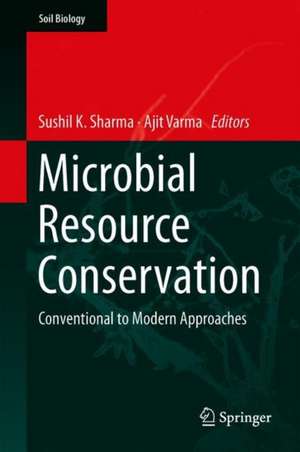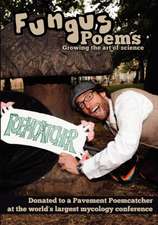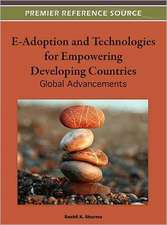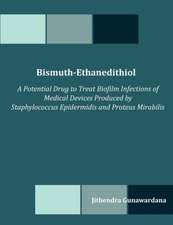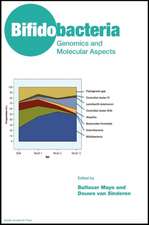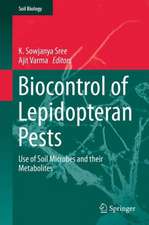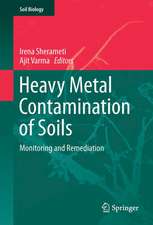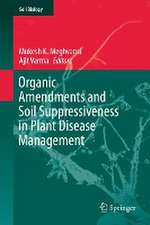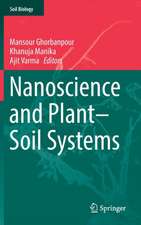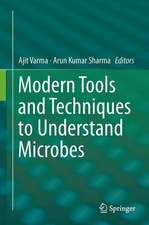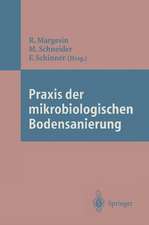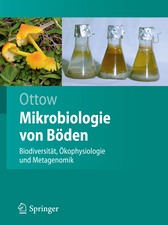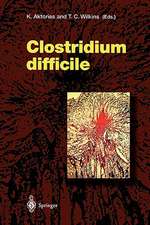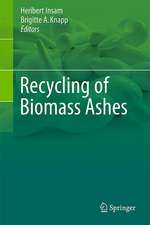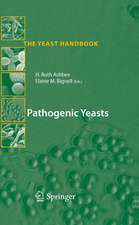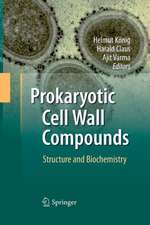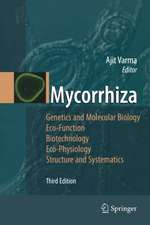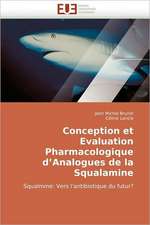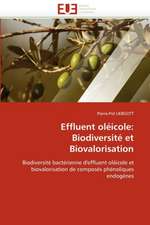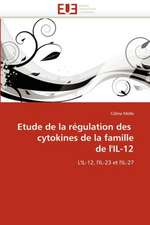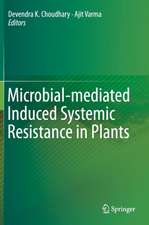Microbial Resource Conservation: Conventional to Modern Approaches: Soil Biology, cartea 54
Editat de Sushil K. Sharma, Ajit Varmaen Limba Engleză Hardback – 12 noi 2018
This book covers broad areas in the conservation of microorganisms. It addresses the short, medium and long-term preservation of agriculturally important microorganisms, as well as culture collections and their roles. The respective chapters address topics such as conventional approaches to bacterial, fungal and algal preservation, as well as methods and strategies for preserving recalcitrant microorganisms. Readers will also find the latest insights into the preservation of vesicular-arbuscular (VA) fungi and ecology, diversity and conservation of endophytes, and entamopathogenic fungi. Microbes of animal and dairy origin, their preservation and biosafety issues are also explored.
Microorganisms are the silent and unseen majority of life on Earth, and are characterized by a high degree of genetic and metabolic diversity. It is well documented that no branch of science or society is unaffected by microbial interventions. Researchers have documented microorganisms from such extreme and unique environments as deserts and hydrothermal vents, and with specific traits that are currently being exploited in agriculture, industry, medicine and biotechnological applications. Such great potential can only be found in microorganisms. The aim of this book – the first entirely devoted to the conservation of microorganisms, and to regulatory mechanisms for access and benefits sharing as per Biological Diversity (BD) Act 2002 – is to promote awareness of our world’s microbial wealth, and to introduce readers to strategies and methodologies for the conservation of microorganisms, which could ultimately save human life on Earth.
| Toate formatele și edițiile | Preț | Express |
|---|---|---|
| Paperback (1) | 1224.85 lei 6-8 săpt. | |
| Springer International Publishing – 31 ian 2019 | 1224.85 lei 6-8 săpt. | |
| Hardback (1) | 1231.01 lei 6-8 săpt. | |
| Springer International Publishing – 12 noi 2018 | 1231.01 lei 6-8 săpt. |
Din seria Soil Biology
- 18%
 Preț: 958.56 lei
Preț: 958.56 lei - 18%
 Preț: 1225.62 lei
Preț: 1225.62 lei - 18%
 Preț: 957.75 lei
Preț: 957.75 lei - 18%
 Preț: 1232.09 lei
Preț: 1232.09 lei - 18%
 Preț: 949.90 lei
Preț: 949.90 lei - 18%
 Preț: 1392.95 lei
Preț: 1392.95 lei - 18%
 Preț: 952.26 lei
Preț: 952.26 lei - 18%
 Preț: 1231.32 lei
Preț: 1231.32 lei - 18%
 Preț: 956.03 lei
Preț: 956.03 lei - 18%
 Preț: 948.29 lei
Preț: 948.29 lei - 18%
 Preț: 1224.18 lei
Preț: 1224.18 lei - 18%
 Preț: 1226.90 lei
Preț: 1226.90 lei - 18%
 Preț: 952.26 lei
Preț: 952.26 lei - 18%
 Preț: 942.63 lei
Preț: 942.63 lei - 18%
 Preț: 946.55 lei
Preț: 946.55 lei - 18%
 Preț: 1221.20 lei
Preț: 1221.20 lei - 18%
 Preț: 1225.94 lei
Preț: 1225.94 lei - 18%
 Preț: 946.24 lei
Preț: 946.24 lei - 24%
 Preț: 1051.29 lei
Preț: 1051.29 lei - 18%
 Preț: 1221.02 lei
Preț: 1221.02 lei - 18%
 Preț: 947.98 lei
Preț: 947.98 lei - 18%
 Preț: 948.47 lei
Preț: 948.47 lei - 18%
 Preț: 1222.31 lei
Preț: 1222.31 lei - 18%
 Preț: 1231.64 lei
Preț: 1231.64 lei - 18%
 Preț: 1225.31 lei
Preț: 1225.31 lei - 18%
 Preț: 1229.73 lei
Preț: 1229.73 lei
Preț: 1231.01 lei
Preț vechi: 1501.23 lei
-18% Nou
Puncte Express: 1847
Preț estimativ în valută:
235.58€ • 255.81$ • 197.89£
235.58€ • 255.81$ • 197.89£
Carte tipărită la comandă
Livrare economică 22 aprilie-06 mai
Preluare comenzi: 021 569.72.76
Specificații
ISBN-13: 9783319969701
ISBN-10: 3319969706
Pagini: 708
Ilustrații: XIII, 451 p. 58 illus., 44 illus. in color.
Dimensiuni: 155 x 235 mm
Greutate: 0.83 kg
Ediția:1st ed. 2018
Editura: Springer International Publishing
Colecția Springer
Seria Soil Biology
Locul publicării:Cham, Switzerland
ISBN-10: 3319969706
Pagini: 708
Ilustrații: XIII, 451 p. 58 illus., 44 illus. in color.
Dimensiuni: 155 x 235 mm
Greutate: 0.83 kg
Ediția:1st ed. 2018
Editura: Springer International Publishing
Colecția Springer
Seria Soil Biology
Locul publicării:Cham, Switzerland
Cuprins
1. Microbial Genetic Resources: Status, Conservation, Access and Benefit Sharing (ABS) Regulations.- 2. Concept of Microbial Preservation: Past, Present and Future.- 3. Establishment and Management of Culture Collections of Microorganisms (mBRC): An Overview.- 4. Specialized Microbial Resource Centres: A Driving Force of the Growing Bioeconomy.- 5. Agricultural Microbial Genetic Resources: Application and Preservation at Microbial Resource Centres (mBRCs).- 6. Rhizobia: Culture Collections, Identification and Methods of Preservation.- 7. Biobank for Conservation of Arbuscular Mycorrhizal (AM) Fungi.- 8. Conservation of Fungi: A Review on Conventional Approaches.- 9. Veterinary Type Cultures and their Preservation: Status and Challenges.- 10. Biodiversity Conservation of Phages and Microbial Populations.- 11. Modern Immunochemical Approaches in Microbiology.- 12. Conservation and Application of Microalgae for Biofuel Production.- 13. Desert Truffles in Saudi Arabia: Diversity, Ecology, and Conservation.- 14. Maintenance, Conservation and Regulation of Microbial Resources for Defense Applications.- 15. Diversity, Ecology and Conservation of Fungal and Bacterial Endophytes.- 16. Archaea: Ecology, Application and Conservation.
Notă biografică
Sushil K. Sharma is Principal Scientist (Agricultural Microbiology) and In-charge/Focal Point of National Agriculturally Important Microbial Culture Collection (NAIMCC) at ICAR-National Bureau of Agriculturally Important Microorganisms, MaunathBhanjan, Uttar Pradesh, India which is a designated repository (DR) recognized by National Biodiversity Authority, MoEF&CC, Govt of India. Dr Sharma is an individual member of World Federation for Culture Collections (WFCC). He is involved in coordination work of network project “Application of Microorganisms in Agriculture and Allied Sectors (AMAAS)” operating at different centers in India.His research interests include soil biology, microbiological basis of soil quality assessments,soil solarization and plant growth-promoting rhizobacteria. He is currently working on exploration, collection, characterization and conservation of microbial wealth of India. He is resource person for international, regional and national training/conference/workshops and delivered talk mainly on biofertilization and biofortification of soybean and wheat with Zn and Fe through microbial approaches, P- and Zn-solubilizing bacteria, and status and activities of microbial culture collections, and ex-situ conservation of microorganisms in NAIMCC. He is faculty member of Amity University, Noida for supervising Ph.D students. He is conducting training programs and group meeting for researchers, technical staff and farmers from all over the country on various aspects of microbiology. He has published more than 50 research articles, review articles, book chapters, and technical bulletins in his credit.
Prof Dr Ajit Varma: Ajit Varma has completed his PhD at the age of 25 years from Allahabad University and Former Professor, School of Life Sciences, Jawaharlal Nehru University, India. Presently, he is the Distinguished Scientist & Professor of Eminence of AmityInstitute of Microbial Technology; Pro-Vice Chancellor, Ritnand Balved Education Foundation, and Vice Chairman, Amity Science, Technology & Innovation Foundation Amity University Uttar Pradesh, India. He has published more than 314 papers. Ajit Varma is the Fellow of Alexander-von-Humboldt Society, Germany, elected Fellow of National Academy Agricultural Sciences and Fellow of Microbiology Society of India.
Textul de pe ultima copertă
This book covers broad areas in the conservation of microorganisms. It addresses the short, medium and long-term preservation of agriculturally important microorganisms, as well as culture collections and their roles. The respective chapters address topics such as conventional approaches to bacterial, fungal and algal preservation, as well as methods and strategies for preserving recalcitrant microorganisms. Readers will also find the latest insights into the preservation of vesicular-arbuscular (VA) fungi and ecology, diversity and conservation of endophytes, and entamopathogenic fungi. Microbes of animal and dairy origin, their preservation and biosafety issues are also explored.
Microorganisms are the silent and unseen majority of life on Earth, and are characterized by a high degree of genetic and metabolic diversity. It is well documented that no branch of science or society is unaffected by microbial interventions. Researchers have documented microorganisms from such extreme and unique environments as deserts and hydrothermal vents, and with specific traits that are currently being exploited in agriculture, industry, medicine and biotechnological applications. Such great potential can only be found in microorganisms. The aim of this book – the first entirely devoted to the conservation of microorganisms, and to regulatory mechanisms for access and benefits sharing as per Biological Diversity (BD) Act 2002 – is to promote awareness of our world’s microbial wealth, and to introduce readers to strategies and methodologies for the conservation of microorganisms, which could ultimately save human life on Earth.
Caracteristici
Provides latest information on conventional and modern methods of preservation of diverse microbes Attracts readers from pharma, agriculture, biotechnology, and industry as conservation of microbial resources is increasingly important for their utilization Is a source of knowledge in conventional methodologies for conservation Numerous illustrations make this book a valuable read
